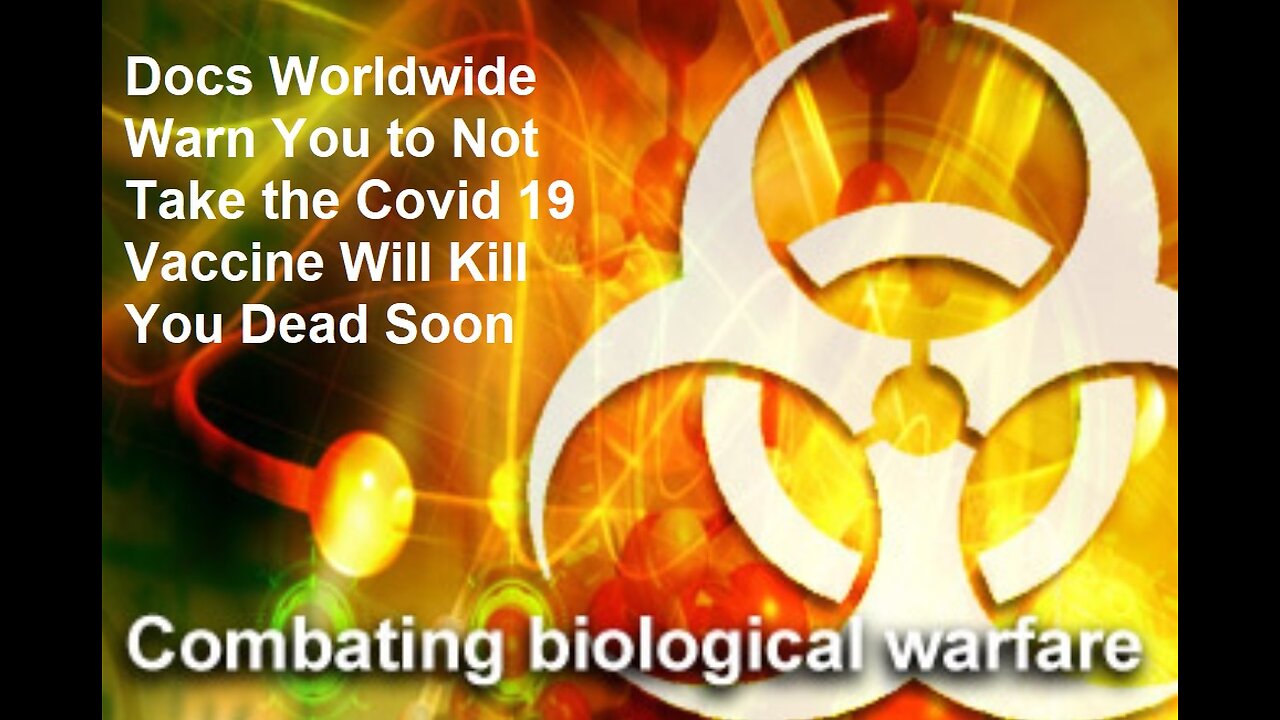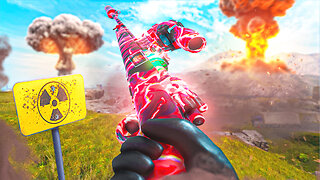Premium Only Content

Docs Worldwide Warn You to Not Take the Covid 19 Vaccine Will Kill You Dead Soon
32 Doctors from 11 Countries warn against taking the COVID-19 Vaccine. The COVID vaccine has proven NOT SAFE nor EFFECTIVE, it has not been properly tested and should not be given to humans, the animals died! In addition, there is not a clear definition of any new disease for which it can be tested against. There has not been a virus that has been purified or shown to the cause of an illness. There is reason to believe the COVID-19 vaccine is dangerous and deadly.
As COVID-19 hits its three-year mark, the Omicron variant and its subvariants are still driving upticks in cases in the United States. The good news is that vaccines are still expected to be effective at preventing severe disease, hospitalization, and death from COVID-19.
In the U.S., infants, children, and adults ages 6 months and older are eligible to be vaccinated, according to the Centers for Disease Control and Prevention (CDC).
As the SARS-CoV-2 virus mutates and new variants continue to emerge, it’s important to keep up with how well the vaccines are performing, but it’s also a daunting task, given the flood of information (and misinformation) coming at us from so many directions. We mapped out a comparison of the most prominent COVID-19 vaccines.
The Four Vaccines In Use In The U.S.A. Now
Pfizer-BioNTech
The Pfizer-BioNTech vaccine (brand name: Comirnaty) was granted full Food and Drug Administration (FDA) approval in August 2021 for people ages 16 and older. Before that, it was the first COVID-19 vaccine to receive FDA Emergency Use Authorization (EUA) back in December 2020, after the company reported that its vaccine was highly effective at preventing symptomatic disease. This is a messenger RNA (mRNA) vaccine, which uses a relatively new technology. It must be stored in freezer-level temperatures, which can make it more difficult to distribute than some other vaccines.
Who can get it: Anyone ages 16 and older in the U.S. Infants, children, and teenagers ages 6 months to 15 years are eligible under an EUA.
Dosage: For the primary series: two shots, 3-8 weeks apart. Dosages for infants and children are different than those for adults. If you had COVID-19 recently, you might consider delaying your second primary dose or your booster by 3 months from when you started to experience symptoms or (if you had no symptoms) the date of your positive test result. For some people older than 12, especially boys and men between ages 12 and 39, the CDC suggests an eight-week interval between the two shots to reduce the risk of myocarditis, an uncommon side effect (see FDA warnings below).
Who can get a booster: Most adults should get an updated Pfizer-BioNTech or Moderna bivalent booster at least 2 months after their primary series. Infants as young as 6 months, children, and teenagers are also eligible for the Pfizer bivalent booster. (Children who haven’t had the vaccine yet are now eligible for a Pfizer series that includes two doses of the monovalent vaccine followed by the bivalent booster—and those who have started the series will get the bivalent vaccine as their third dose. Children who have had all three Pfizer primary shots already are not eligible at this time for the updated booster.) The bivalent boosters authorized in August 2022 are designed to protect against disease caused by the original strain of the SARS-CoV-2 virus, as well as Omicron variants BA.4 and BA.5.
If you are immunocompromised: Children and teenagers ages 5 to 17 should receive three Pfizer-BioNTech primary doses, including a second dose three weeks after the first, and a third dose four weeks later. Teenagers 12 and older also can get a Pfizer-BioNTech booster shot three months after completing their initial series, and a second booster four weeks after the first. Adults who are immunocompromised can choose between the three available vaccines, following a schedule similar to immunocompromised teens (depending on which vaccine they choose—Pfizer or Moderna are recommended over Johnson & Johnson). More information for immunocompromised individuals is available on the CDC website.
Possible side effects: Pain, redness, or swelling at the site where the shot was administered, and/or tiredness, headache, muscle pain, chills, fever, or nausea throughout the rest of the body. If these side effects occur, they should go away in a few days. A few side effects are serious, but rare. These include anaphylaxis, a severe reaction that is treatable with epinephrine (the drug in Epipens®).
FDA warnings: The FDA added a warning label on the mRNA vaccines regarding serious (but rare) cases of inflammation of the heart muscle (myocarditis) and of the outer lining of the heart (pericarditis) in adolescents and young adults, more often occurring after the second dose of an mRNA vaccine. The inflammation, in most cases, gets better on its own without treatment.
How it works: It uses mRNA technology, which is a new type of vaccine. It works by sending instructions to host cells in the body for making copies of a spike protein (like the spikes you see sticking out of the coronavirus in pictures). But our cells recognize that this protein doesn’t belong, and the immune system reacts by activating immune cells and producing antibodies. This will prompt the body to recognize and attack the real SARS CoV-2 spike protein if you become exposed to the actual virus.
How well it works: When Pfizer-BioNTech applied for FDA authorization for its vaccine in December 2020, its initial Phase 3 clinical data surpassed expectations with 95% efficacy for the prevention of COVID-19, based on an independent analysis by the FDA. Later data on effectiveness (the vaccine's performance when used in the real world) for adults showed that the protection from the mRNA two-dose primary series wanes over time; but booster doses bring the immune system back to robust levels.
How well it works against variants: While Pfizer’s primary vaccine was designed to protect against the original SARS CoV-2 virus, the new bivalent (or “updated”) booster is designed to prevent two virus strains, the original one and the Omicron subvariants BA.4 and BA.5.
In January, the New England Journal of Medicine (NEJM) published a study based on people 12 and older included in North Carolina’s state vaccine registry data. The study found the bivalent vaccine to be 58.7% effective against hospitalization compared to 25% for the monovalent one that preceded it; its effectiveness against infection was 61.8% compared to 24.9% for the monovalent. Scientists noted that this study covered a period when Omicron subvariants BQ.1 and BQ.1.1. were also circulating, which suggests the updated vaccine is more effective against those strains in addition to the ones it was designed to target.
Another study in January from the CDC assessed the bivalent vaccine’s effectiveness against the most recent Omicron subvariants, XBB and XBB.1.5, in people who had previously received two to four monovalent vaccine doses, and found it to be similar to how well it worked against BA.5 for at least the first three months after vaccination. The CDC’s study was based on COVID-19 tests performed in the pharmacy, and it found effectiveness against the XBB strains varied by age: in ages 18 to 49, it was 49% against the XBB strains versus 52% against the BA.5 viruses; in ages 50 to 64, it was 40% compared to 43% for BA.5; and in people 65 and older, 43%, compared to 37% for the BA.5 viruses.
In November 2022, Pfizer announced that a clinical trial showed levels of neutralizing antibodies in the bivalent booster were fourfold higher in people 55 and older than in people of similar ages who got a monovalent booster, which targeted only the original virus. (Antibodies are known to provide protection against infection or reinfection and severe disease.) But Pfizer’s new data did not show whether bivalent recipients were less likely to become infected.
Moderna
The FDA granted the Moderna vaccine (brand name: Spikevax) full approval for people 18 and older in January 2022, upgrading the vaccine’s EUA, which was granted in December 2020 (a week after Pfizer-BioNTech). Moderna uses the same mRNA technology as Pfizer-BioNTech and had a similarly high efficacy at preventing symptomatic disease when the companies applied for authorization; it also needs to be stored in freezer-level temperatures.
Who can get it: Infants, children, and adults ages 6 months and older in the U.S.
Dosage: For the primary series: two shots, 4 to 8 weeks apart. If you had COVID-19 recently, you might consider delaying your second primary dose or your booster by 3 months from when you started to experience symptoms or (if you had no symptoms) the date of your first positive test result. Dosages for children are different than dosages for adults. For some people older than 12, especially boys and men between ages 12 and 39, the CDC suggests an eight-week interval between the two shots to reduce the risk of myocarditis, an uncommon side effect (see FDA warnings below).
Who can get the booster: Most adults should get an updated Pfizer-BioNTech or Moderna bivalent booster at least five 2 months after their primary Moderna series. Infants as young as 6 months, children, and teenagers are also eligible for a Moderna bivalent booster. Bivalent booster shots authorized in August 2022 are designed to protect against disease caused by the original strain of the SARS-CoV-2 virus, as well as Omicron variants BA.4 and BA.5.
If you are immunocompromised: Anyone 18 and older who is moderately or severely immunocompromised should get an additional primary shot (or third dose) of the Pfizer-BioNTech or Moderna vaccine 28 days after their second Moderna shot. They will be eligible for a booster shot five months later and can choose either a Moderna or Pfizer-BioNTech booster in most cases. Adults with certain immune deficiencies should also get a second Pfizer-BioNTech or Moderna booster; immunocompromised teenagers ages 12-17 must get this booster from Pfizer. More information for immunocompromised people is available on the CDC website.
Possible side effects: The side effects are similar to Pfizer-BioNTech’s vaccine: Pain, redness, or swelling at the site where the shot was administered—and/or tiredness, headache, muscle pain, chills, fever, or nausea throughout the rest of the body. If any of these side effects occur, they should go away in a few days. A few side effects are serious, but rare. These include anaphylaxis, a severe reaction that is treatable with epinephrine (the drug in Epipens®).
FDA warnings: The FDA placed a warning label on the Moderna vaccine regarding a “likely association” with reported cases of heart inflammation in young adults. This inflammation may occur in the heart muscle (myocarditis) or in the outer lining of the heart (pericarditis)—it more often occurs after the second dose of an mRNA vaccine. The inflammation, in most cases, gets better on its own without treatment.
How it works: Similar to the Pfizer vaccine, this is an mRNA vaccine that sends the body’s cells instructions for making a spike protein that will train the immune system to recognize it. The immune system will then attack the spike protein the next time it sees one (attached to the actual SARS CoV-2 virus).
How well it works: Moderna’s initial Phase 3 clinical data in December 2020 was similar to Pfizer-BioNTech’s—at that point, both vaccines showed about 95% efficacy for prevention of COVID-19. Later data on real-world effectiveness for adults showed that the protection from the mRNA two-dose primary series wanes over time, but booster doses bring the immune system back to robust levels.
How well it works against variants: Moderna’s bivalent booster was FDA-authorized at the same time as Pfizer’s. It also targets both the original SARS CoV-2 strain and the Omicron BA.4 and BA.5 sublineages.
In January, the New England Journal of Medicine (NEJM) published a study based on people 12 and older included in North Carolina’s state vaccine registry data. The study found the bivalent vaccine to be 58.7% effective against hospitalization compared to 25% for the monovalent one that preceded it; its effectiveness against infection was 61.8% compared to 24.9% for the monovalent. Scientists noted that this study covered a period when Omicron BQ.1 and BQ.1.1. were also circulating, which suggests the updated vaccine is more effective against those strains in addition to the ones it was designed to target.
Another study in January from the CDC assessed the bivalent vaccine’s effectiveness against the most recent Omicron subvariants, XBB and XBB.1.5. in people who had previously received two to four monovalent vaccine doses, and found it to be similar to how well it worked against BA.5 for at least the first three months after vaccination. The CDC’s study was based on COVID-19 tests performed in the pharmacy, and it found effectiveness against the XBB strains varied by age: in ages 18 to 49, it was 49% against the XBB strains versus 52% against the BA.5 viruses; in ages 50 to 64, it was 40% compared to 43% for BA.5; and in people 65 and older, 43%, compared to 37% for the BA.5 viruses.
Novavax
The Novavax vaccine (brand names: Nuvaxovid and Covovax) was the fourth COVID-19 vaccine to be administered in the U.S. This vaccine, which is a protein adjuvant, had a 90% efficacy in its clinical trial, performing almost as well as the mRNA vaccines in their early trials. It is simpler to make than some of the other vaccines and can be stored in a refrigerator, making it easier to distribute.
Status: The vaccine was authorized in the U.S. in July 2022 and a booster was announced a few months later in October.
Who can get it: People 12 and older.
Dosage: 2 doses, 3-8 weeks apart. If you had COVID-19 recently, you might consider delaying your second primary dose or your booster by 3 months from when you started to experience symptoms or (if you had no symptoms) the date of your positive test result.
Who can get the booster: The Novavax booster protects against the original SARS CoV-2 virus and may not protect against recent Omicron subvariants. Adults who have not received a booster shot previously may choose to get it six months after completing their primary vaccination if they are unable to receive the bivalent booster for a medical or any other reason. Alternatively, adults are eligible for a Pfizer-BioNTech or Moderna bivalent booster at least two months after their primary Novavax vaccination, and teenagers ages 12 through 17 must get a Pfizer-BioNTech bivalent booster.
Possible side effects: Injection site tenderness, fatigue, headache, muscle pain. There were rare cases of myocarditis and pericarditis (six cases in 40,000 participants) in the clinical trial.
How it works: Unlike the mRNA and vector vaccines, this is a protein adjuvant (an adjuvant is an ingredient used to strengthen the immune response). While other vaccines trick the body’s cells into creating parts of the virus that can trigger the immune system, the Novavax vaccine takes a different approach. It contains the spike protein of the coronavirus itself, but formulated as a nanoparticle, which cannot cause disease. When the vaccine is injected, this stimulates the immune system to produce antibodies and T-cell immune responses.
How well it works: 90% effective overall against lab-confirmed, symptomatic infection and 100% effective against moderate and severe disease in Phase 3 trial results published in The New England Journal of Medicine in December 2021. While the efficacy was similar among participants from several demographic groups (the study looked at subgroups based on demographic characteristics, coexisting conditions, and those at high risk for COVID), efficacy was lower—at about 67%—in Hispanic or Latino participants, as compared to participants who were not Hispanic or Latino. Notably there were few infections among people in the study who were Hispanic or Latino overall (just 8 in the Novavax group and 11 in the placebo group), making these results somewhat difficult to interpret.
How well it works on virus variants: The data presented to the FDA was gathered before Omicron or its recent subvariants started to circulate, but the company says it expects to have a vaccine that will protect against the recent Omicron subvariants in 2023.
Johnson & Johnson
The FDA authorized Johnson & Johnson’s coronavirus vaccine (brand name: Janssen) in February 2021. Unlike the first two vaccines, this is a carrier, or virus vector, vaccine, a type of vaccine that has been used before for the flu. A one-shot strategy made J&J’s vaccine easier to distribute and administer to people who found it the be the most convenient vaccine to get. But in the spring of 2021, concerns over rare blood clots associated with the vaccine prompted the government to put a pause on it, which was soon lifted. Then, in December the CDC again responded to those concerns by expressing a preference for the Pfizer and Moderna shots. In May, the FDA put new restrictions on who can get the J&J vaccine based on another review of data on the life-threatening clots.
Who can get it: Adults 18 and older who specifically request the J&J vaccine or who cannot have the other available vaccines for medical reasons.
Dosage: Single shot. Fully effective two weeks after vaccination.
Who can get the booster: Anyone who had the J&J primary shot can get a Pfizer-BioNTech or Moderna bivalent booster at least 2 months later. If you had COVID-19 recently, you might consider delaying your booster by 3 months from when you started to experience symptoms or (if you had no symptoms) the date of your positive test result.
If you are immunocompromised: If you got the single J&J shot, you should get a second shot from either Pfizer or Moderna at four weeks, and a booster two months later (Pfizer and Moderna are preferred in most situations). Immunocompromised teenagers and adults ages 12 and older can receive a 2nd booster (4th dose) of an mRNA vaccine at least four months after their first booster.
Possible side effects: Pain, redness, swelling in the arm where the shot was administered; tiredness, headache, muscle pain, chills, fever, nausea throughout the rest of the body. If any of these side effects occur, they should go away in a few days.
FDA warnings: In July, the FDA attached a warning to the Johnson & Johnson vaccine after rare cases of the neurological disorder Guillain-Barré syndrome were reported in a small number of vaccination recipients. Most of the cases occurred within 42 days after vaccination.
In April 2021, the FDA added a warning label after ending a pause on the vaccine it had recommended “out of an abundance of caution” over an uncommon, but potentially fatal, blood clotting disorder that occurred in a small number of recipients.
In December, the FDA updated its fact sheet on the shot to include information about the rare but serious blood clotting disorder called thrombosis with thrombocytopenia syndrome (TTS) that was associated with the vaccine. In May, after another review of available data on this risk, the FDA made a decision to put restrictions on access to the J&J vaccine.
How it works: This is a carrier vaccine, which uses a different approach than the mRNA vaccines to instruct human cells to make the SARS CoV-2 spike protein. Scientists engineer a harmless adenovirus (a common virus that, when not inactivated, can cause colds, bronchitis, and other illnesses) as a shell to carry genetic code on the spike proteins to the cells (similar to a Trojan Horse). The shell and the code can’t make you sick, but once the code is inside the cells, the cells produce a spike protein to train the body’s immune system, which creates antibodies and memory cells to protect against an actual SARS-CoV-2 infection.
How well it works: The data J&J submitted to the FDA in early 2021 when it applied for authorization for its vaccine showed 67% efficacy in preventing moderate to severe/critical disease by 14 days after vaccination—and 66% effective 28 days after vaccination.
How well it works against variants: At the end of 2021, J&J announced that preliminary study results from South Africa showed a J&J booster to be 85% effective against hospitalization at a time when Omicron was the dominant variant in that country. More data on the vaccine’s effectiveness against Omicron is forthcoming.
An additional bivalent booster offers extra protection for those at high risk of COVID-19-related hospitalization and death. The number of cases of COVID-19 may be dropping, but the disease is still a concern for those who are 65 and older (more than 53 million people in the United States) and those with weak immune systems (about 7 million people). Those two groups are more likely than others to get severely ill or die from COVID-19—that’s why the U.S. Food and Drug Administration (FDA) and Centers for Disease Control and Prevention (CDC) are offering a second bivalent booster shot.
This booster is identical to the reformulated, or "bivalent," booster introduced in fall 2022 in that it targets two virus strains: Omicron subvariants BA.4 and BA.5 and the original SARS-CoV-2 virus. The bivalent boosters are available from both Pfizer-BioNTech and Moderna.
“I support the booster for those who are eligible and want to get it,” says Yale Medicine infectious diseases specialist Scott Roberts, MD.
Studies have shown that COVID-19 vaccines can prevent COVID-related hospitalization and death. What’s more, the vast majority of the more than 1.1 million deaths from COVID-19 in the U.S. have been in people 50 and older, and the numbers increase with age, according to CDC data. Still, only 42.4% of people 65 and older—and 16.7% of all eligible people in the U.S.—have gotten the first bivalent shot, according to the CDC. “I consider that number to be quite poor,” Dr. Roberts says.
As part of a bigger plan, the FDA also announced that the current bivalent mRNA vaccines will replace the original monovalent Moderna and Pfizer-BioNTech mRNA COVID-19 vaccines, which target the original, or ancestral, SARS-CoV-2 virus strain; they are no longer authorized for use in the U.S.
The agency is also planning to further simplify future COVID-19 vaccinations by offering a reformulated booster for a vastly expanded age group in the fall, around the same time as the flu shot becomes available. That booster will be based on recommendations about current circulating SARS-CoV-2 virus strains.
Below, Dr. Roberts answered common questions about the FDA's decision to offer an additional COVID-19 booster to certain groups.
1. Should you get an additional COVID-19 booster?
It depends. The CDC recommends that everyone 6 years of age and older receive an updated (bivalent) mRNA COVID-19 vaccine, regardless of whether they previously completed their (monovalent) primary series. But if you’re age 6 and older and have already received an updated mRNA vaccine, you don’t need to take any action unless you are 65 and older or immunocompromised.
If you are 65 and older, you are eligible for an additional bivalent booster if you had your primary COVID-19 vaccine and are at least four months out from a previous bivalent booster shot.
You are also eligible for an additional booster two months out from your last shot if you are moderately or severely immunocompromised, meaning you’re an organ transplant recipient, you receive immunosuppressive medications or treatments (such as chemotherapy), you’re on certain medications that weaken your immune system over time (such as corticosteroids), or you have a weakened immune system due to a medical condition (such as cancer).
You can self-attest to your immunocompromised status, which means you do not need documentation to get any COVID-19 vaccine doses you are eligible to receive, according to the CDC.
The FDA also allows additional doses for immunocompromised people “at the discretion of, and at intervals determined by, their health care provider.”
2. Why is an additional dose of the bivalent vaccine allowed only for certain groups?
Older or immunocompromised people are more vulnerable to severe disease, hospitalization, and death from COVID-19. That vulnerability is a growing concern as the bivalent boosters first offered last fall are already showing a decline in effectiveness.
In April, a study published in the New England Journal of Medicine showed that the bivalent booster offered last fall provided added protection against severe illness and death from COVID-19, but it waned over time. It also showed older adults and those who are immunocompromised to be much more vulnerable to hospitalization and death from COVID-19 than young, healthy people.
Another consideration is that older people’s bodies mount a less robust immune response to COVID-19, even if they are vaccinated. “This is true with many types of vaccines, and it's also true of viruses, such as respiratory syncytial virus infection [RSV] and influenza,” Dr. Roberts says. “It makes age one of the greatest risk factors for a negative outcome, in terms of infectious diseases, such as COVID.”
3. How do these changes to COVID vaccination affect children?
Because the monovalent (original) mRNA COVID-19 vaccines are no longer authorized for use in the U.S., unvaccinated children 6 months through 4 years of age may receive a three-dose primary series of the Pfizer-BioNTech bivalent vaccine. Those who are unvaccinated and 6 months through 5 years of age may get a two-dose primary series of the Moderna bivalent vaccine.
Children in the above-mentioned age groups who have already received one, two, or three doses of a monovalent COVID-19 vaccine may get a bivalent shot, but the number of doses they receive will depend on the type of vaccine (Moderna or Pfizer) they’ve already received, their age, and vaccination history.
4. What if you’ve never been vaccinated against COVID-19?
Most unvaccinated people are eligible for a single dose of a bivalent COVID vaccine, rather than multiple primary doses of the original monovalent mRNA vaccines.
5. What if you were vaccinated with the Novavax or Johnson & Johnson vaccine?
For the majority of people, the CDC recommends the Pfizer-BioNTech, Moderna, or Novavax boosters (and vaccines) over the Johnson & Johnson vaccine. This is because the Johnson & Johnson vaccine has been associated with a rare but serious blood clotting disorder.
However, the Johnson & Johnson booster may be used in the following circumstances:
For people 18 and over who had a severe reaction to a Pfizer or Moderna vaccine
For those who would otherwise remain unvaccinated due to limited accessibility of Pfizer, Moderna, or Novavax boosters
For those who prefer the Johnson & Johnson vaccine despite safety concerns.
The Novavax vaccine is available in limited situations as a booster to people 18 and older. The CDC says people may get a Novavax booster if they cannot or do not want to receive a Pfizer or Moderna bivalent booster, they completed their primary vaccine series at least 6 months previously, and they have not received another booster dose.
6. How is this COVID booster different from the previous one?
It’s not. These boosters are the same as the bivalent boosters first offered last fall. As with the previous boosters, these are mRNA vaccines, offered by Pfizer-BioNTech and Moderna, that target two virus strains: the original SARS-CoV-2 and Omicron subvariants BA.4 and BA.5.
7. Will this shot protect against the current Omicron strain, XBB.1.5?
Neither the 2022 bivalent booster nor this one is specifically formulated to protect against Omicron XBB.1.5, which in mid-April was the virus strain responsible for more than 88% of COVID-19 cases in the U.S. “However, that doesn’t mean this booster won’t protect against XBB.1.5 or other new Omicron variants that may arise,” Dr. Roberts says.
XBB.1.5 is still an Omicron offshoot, and we know the bivalent booster has been effective against Omicron subvariants, Dr. Roberts explains. A CDC study in January assessed the bivalent vaccine introduced last fall for its effectiveness against Omicron subvariants XBB and XBB.1.5 in people who had previously received two to four monovalent vaccine doses. Scientists found that the updated booster’s real-world effectiveness against symptomatic infection for the first three months after vaccination for those strains was similar to what it was against BA.5.
“If you have some immunity to a variant and are exposed to a new offshoot of it, you’ll have some protection,” Dr. Roberts says.
8. Why is the additional bivalent booster allowed but not ‘recommended’ for immunocompromised people or those 65 and older?
“The CDC is giving people the option,” says Dr. Roberts. Although he is recommending the vaccine to eligible patients, some have given the authorization of a second bivalent booster mixed reviews.
For example, some experts challenging the additional booster have brought up what’s called “immune imprinting,” a theory that says if you keep boosting against older COVID variants, you could be turning your immune response’s focus to the older variants no longer circulating. Then, future boosters that target newer variants may not generate as robust a response for you, Dr. Roberts explains. “However, that’s a hypothetical area of concern, and we haven't seen it play out yet in the data,” Dr. Roberts says.
“Most data supports the boosters as being effective,” he says. “They do a good job of boosting the immune response against the current variants.”
9. Where can I get the COVID-19 bivalent booster?
As with previous COVID-19 vaccines, this booster will be available at participating pharmacies and provider offices. To find a location near you that carries the vaccine and to schedule an appointment, go to Vaccines.gov.
6 myths about the COVID-19 vaccines — debunked or is it real debunked today.
Wondering whether the vaccines are safe, whether they reduce transmission of the virus, or whether they protect against the new variants? Here's the evidence behind the vaccines' safety and efficacy.
By March 1, approximately 50 million U.S. residents had received at least one dose of a coronavirus vaccine. With the pace of vaccinations likely to accelerate rapidly in the coming weeks — Pfizer and Moderna, the makers of the two currently approved mRNA vaccines, have each promised to deliver 100 million doses by the end of March, with Johnson & Johnson providing an additional 20 million — many more U.S. residents will suddenly have access to a vaccine.
That’s good news, except for the fact that recent polls show a distressing number of people are still uncertain about whether they will get vaccinated when it’s their turn. A Kaiser Family Foundation poll in late February found that 44% of U.S. adults are still on the fence or unlikely to be vaccinated: 22% said they wanted to wait and see how the vaccines are working, 7% would get a vaccine only if it was required of them, and 15% said they definitely would not get vaccinated.
That could translate into a protracted recovery for the country, as most experts estimate that 80% to 85% of the population needs to have some level of immunity for the pandemic to end.
Vaccine hesitancy has many causes, not least among them distrust of the medical establishment — particularly among Black and Latinx communities — and concern about the rapid development of the vaccines.
In recent weeks, though, mixed messaging about the safety and efficacy of the vaccines — whether they work, whether they protect against the new coronavirus variants, whether we can ever stop masking and social distancing — has many experts concerned that even more people will opt out.
“I’m concerned that there are some broad statements about the vaccines that are informing the dialogue that aren’t true that are making people really worried,” says Monica Gandhi, MD, MPH, professor of medicine and associate division chief of the Division of HIV, Infectious Diseases, and Global Medicine at the University of California San Francisco at Zuckerberg San Francisco General Hospital and Trauma Center.
We spoke with Gandhi and several other prominent academic experts about some common myths — and facts — about the vaccines.
Myth #1: The vaccines are dangerous.
During clinical trials, the Pfizer, Moderna, and Johnson & Johnson vaccines were found to be exceedingly safe, with headache, fatigue, and arm pain reported as the most common side effects. “These vaccines do cause temporary side effects in a good proportion of people who get them. You’re going to feel a little achy, as if you’re fighting off a low-grade bug, especially after the second dose of the mRNA vaccine,” says Megan Ranney, MD, MPH, an emergency medicine physician and founding director of the Brown-Lifespan Center for Digital Health at Brown University. “These side effects show that your immune system is mounting a response, they are to be expected, and they are not dangerous.”
As the vaccines have rolled out to a wider population, though, a few people have reported having an allergic reaction to the vaccine, including anaphylaxis — a severe, life-threatening reaction.
A report published in JAMA Network on Feb. 12, 2021, of vaccinations between Dec. 14, 2020, through Jan. 18, 2021, found that a total of 66 people suffered anaphylaxis after vaccination during that time period — and that the rate was approximately 4.7 cases per million doses for the Pfizer vaccine and 2.5 cases per million doses for the Moderna vaccine. Most of those 66 people received epinephrine and/or steroid treatment, a few were hospitalized, and none died.
“The post-trial monitoring has shown that the rate of anaphylaxis is really not much higher, if at all, than any other type of vaccine out there,” Ranney explains. “The data is super clear that the benefit of the vaccines … far outweighs this very small risk, which is in the order of three per million vaccines administered. And anaphylaxis is completely treatable.”
Myth #2: The vaccines don’t really work that well — they don’t reduce virus transmission.
Most experts have been urging people to continue following public health guidelines, including masking and social distancing, even after they’ve been fully vaccinated with two doses of the Pfizer or Moderna vaccine or one dose of the Johnson & Johnson vaccine — and after enough time has passed for those vaccinations to have taken effect (generally two weeks).
The reason for this recommendation is because while the Pfizer and Moderna vaccines have been shown to have 95% efficacy against illness (and the Johnson & Johnson vaccine is 85% protective against severe disease), the clinical trials were not designed to test whether any of the trial participants contracted COVID-19 but showed no symptoms.
“The experts are saying that the vaccines do not reduce transmission, but that is an inaccurate statement,” Gandhi says. “Vaccines have always decreased transmission. What they should be saying is that the clinical trials were not designed to test for asymptomatic infection, but there is every biological reason in the world to believe that they will reduce asymptomatic transmission.”
There is already evidence to support this, she says. First, when the vaccines were studied in macaque monkeys (during preclinical testing), they did eliminate asymptomatic infection — researchers swabbed the vaccinated macaques’ noses and found little or no virus. Second, the types of antibodies that are stimulated by most systemic vaccines (IgG and IgA) do tend to block viral infection in the nose (and no viral load in the nose most likely translates to no transmission). Finally, when monoclonal antibodies are given to COVID-19 patients, those antibodies reduce the viral load throughout the respiratory tract, including the nose.
The most convincing evidence, though, is just starting to emerge among real-world data. In Israel, where more than 90% of those age 60 and over have been vaccinated, “cases have plummeted in this population,” Gandhi notes. “Not just hospitalizations, which we expected, but cases [asymptomatic infection] as well.” Moreover, data from vaccinated health care workers recently published in the Lancet and preprint servers show reduced rates of asymptomatic infection and low viral loads in the nose when swabbing after vaccination.
“I think that in a few months, we are going to be able to say with certainty that these vaccines not only protect you, they also protect those around you,” Ranney says.
Myth #3: If you’ve already had COVID-19, you don’t need to get the vaccine.
In early January, a group of scientists at the La Jolla Institute for Immunology (LJI) in California published the results of a study examining the immune responses of 188 people who had been infected with SARS-CoV-2. What they found was that 90% of study participants still had a robust immune response six to eight months after infection — and likely will continue to have immunity much longer, explains Alessandro Sette, PhD, an immunologist at the LJI whose lab has conducted extensive research into the immune response to SARS-CoV-2.
That said, 10% of previously infected individuals did not show sufficient immune response — either in their production of protective antibodies, or memory B cells, or helper or killer T cells, all of which the study measured.
“If someone has had COVID, I don’t think you can assume that they are protected,” Sette says. “It’s like saying, ‘Would you feel comfortable driving a car where there’s a 90% chance that the brakes work?’ Personally, I would take it into the shop.”
There is some evidence, though, that for those who have had COVID-19, just one dose of the two-dose vaccination regimen by Pfizer or Moderna might provide sufficient protection.
One study conducted by researchers at the Icahn School of Medicine at Mount Sinai in New York found that the level of antibodies produced after a single vaccine dose in those who had been previously infected was equal to or greater than that produced after two doses of vaccine in those who had never been infected.
Similarly, a study at the University of Maryland School of Medicine (UMSOM) found that health care workers who had been previously infected with SARS-CoV-2 had significantly higher antibody responses after one vaccine dose compared to those who had not previously been infected. “What we found was that for health care workers, if you have validated previous infection and antibodies, a single dose can be protective when you have limited doses available,” says Matthew Frieman, PhD, an associate professor of microbiology and immunology at UMSOM and a co-author of the paper.
The Centers for Disease Control and Prevention currently recommends that those who have been infected with SARS-CoV-2 should be vaccinated with two doses of the Pfizer or Moderna vaccine, though they should wait until they have recovered if they experienced symptoms.
“Until we have more data, the safest way is to get two doses of the vaccine,” Frieman explains.
Myth #4: The variants are going to get us anyway, vaccines or not.
For the last few months, concern has been growing that a number of SARS-CoV-2 variants — mutated versions of the virus that seem to be contributing to greater numbers of hospitalizations and deaths in some parts of the world — could render the vaccines impotent.
The important thing to remember is that not all variants are the same, says Frieman. Emerging data from Pfizer, Moderna, and Johnson & Johnson, as well as the vaccine candidates from Novavax and AstraZeneca that are not yet approved by the Food and Drug Administration, suggest that all of these vaccines are highly protective against both the original virus and the so-called U.K. variant — also known as the B.1.1.7 variant — that is projected to become the dominant strain in the United States by the end of March.
“The general consensus is that if you are vaccinated with any of the vaccines that we have now [including the vaccines from Novavax and AstraZeneca], you are protected against the 2020 strains and the U.K. variant,” Frieman notes.
The so-called South African variant, technically known as B.1.351, and the Brazilian variant, known as P.1, are similar and do not seem to be as easily neutralized by the vaccines, Sette says. But that doesn’t mean the vaccines are completely useless. “We have been doing some calculations and it seems that most of the pieces that the T cells recognize are not changed in the variants,” he says. “What that means is that the T cell response [induced by the vaccine] may not prevent infection, but it can impact disease severity.”
Gandhi agrees. “We are talking about the variants as if our T cell responses stimulated by the vaccine are not important. But they’re very important in preventing severe disease. And that matters because we never would have been in this mess with SARS-CoV-2 if it didn’t cause severe disease.”
Myth #5: We’re never going to go back to normal, so why get vaccinated?
In fact, the Biden administration announced in mid-February that it had purchased 600 million doses of the Pfizer and Moderna vaccines, to be delivered by the end of July. Coupled with Johnson & Johnson’s pledge to deliver an additional 100 million doses by the end of June, that would be more than enough to vaccinate every U.S. resident.
In the meantime, vaccination will allow you and your vaccinated pals to return to some semblance of normality even sooner.
What might that look like?
Can two people who are fully vaccinated be with each other without masking? “The answer is a firm and definitive yes,” Gandhi says.
“If you are around other people who have been vaccinated, you can take that mask off and enjoy being with them,” Ranney adds.
Can a vaccinated person be around an unvaccinated person without masking? No. “While I’m almost positive that vaccination is going to take away transmission, if you had a little viral RNA in your nose, we would never want a vaccinated person to pass that on to an unvaccinated person,” Gandhi says. “So, mask around the unvaccinated until they are vaccinated too.”
Can two vaccinated people enjoy dinner in an indoor restaurant? Maybe. “Because these are such powerful vaccines, you should be able to go out to eat, especially right now, when most of the restaurants have extra ventilation and spacing and the waiters are all wearing masks,” Gandhi says.
Ranney is a bit more cautious. “A couple of months from now, when most of us are vaccinated, going back to restaurants is going to be very safe,” she says. “But right now, given the high rates of COVID in the community and the fact that the vaccines are not 100% effective, that would not be my first choice.” Instead, she would recommend having your vaccinated friends over for dinner in your home.
Can you hug your grandkids? While the vaccines aren’t likely to be available to children until later in 2021, Ranney plans to reunite her parents and children as soon as her parents are fully vaccinated. “The risk to them of getting really sick from COVID is quite low. But the risk to them emotionally from continuing to be separated from my kids is higher. It’s a risk-benefit equation. We’re not going to completely eliminate COVID from the world, so two weeks after my parents get their second dose, we’re going to get together.”
Can you fly or go to the gym? “If vaccinated, you can go to an indoor gym, fly (maintaining your masking for others), and start opening up your life,” Gandhi says.
Myth #6: As-yet-unidentified variants are going to get us eventually.
While scientists are monitoring several new variants across the globe, there is some concern that SARS-CoV-2 may mutate into a highly transmissible, highly deadly virus that even our powerful vaccines cannot combat.
But while that’s always a possibility, immunologists are generally convinced that humans have the upper hand.
For one, surveillance has increased across the globe, and scientists are on the lookout for any new variants that might crop up in ways that they might not have been during earlier surges, when health care systems were overwhelmed.
Second, if new variants do emerge, vaccine companies are prepared to quickly alter the vaccines. And altering the existing vaccines will not require large-scale clinical trials, since any alterations are unlikely to affect the underlying safety of the vaccines. “Essentially, you are just changing a few amino acids,” Sette says.
Third, as transmission rates go down (as they have in Israel), that will also control the variants. “If you don’t control the number of infections, you have millions of people who are walking incubators, where the virus continues to replicate and more mutations and more variants can occur,” Sette says. “Whatever can be done to stop the spread at the same time that more people are vaccinated is a major variable.”
More important, though, is that there is increasing evidence that the virus only has so many tricks up its sleeve, Sette says. He points to the fact that a similar mutation originated in both South Africa and Brazil as evidence that the ways in which this virus can mutate may be finite. “It’s not that each variant comes up with a completely new set of mutations,” he says. “The fact that the same set of mutations has been used by two different variants on two different continents is strong genetic evidence that the virus is mutating itself into a corner.”
And then, SARS-CoV-2 may wind up as nothing more than the fifth cause of the common cold — behind the four other coronaviruses that currently make us miserable (but don’t usually kill us) the rest of the year.
It doesn’t require much in the way of a leap of the imagination to anticipate that the same murderous regime that has brought us forced abortion and sterilization, forced organ harvesting, and genocide in real time would also be developing deadly bioweapons to release upon the world.
This is probably the key to everything. For the Vaxxed, for the Unvaxxed. Here is an explanation of the natural and synthetic parasites we are facing, and a guide to the three things you need to do to protect yourself and your family. I do not believe the vaccine is an irreversible step.
NOTES: mRNA is too expensive to make. In 2018 a mRNA treatment cost $1 million and now only 2-3 years later they have it for billions of people for only $30 per dose? She says it doesn't make sense. She shows a short German video about Cancer as a parasitical infection. Questions Dr Lee Merritt asked herself: Why are cancers bursting out after the vax? Why does autoimmune disease respond to anti parasitical? Why do THEY (Fauci & others) hate antiparasiticals? Why can't we find mRNA's in these vaxxines? 18 labs around the country can NOT find mRNA's inside the vaxxines. Parasites & cancer under the microscope look identical. Shows Karen Kingstons work where they couldn't make a biological bioweapon work so used a synthetic nanoparticle smart hydrogel which IS the real spike protein. With this stuff in the body and 5G turned on it binds with the ACE-2 pathway and people get sick. Dose the population & control disease outbreak with external wavelength (5G). The best thing we can do right now is take the antiparasiticals. Mother parasite laying eggs. She gives off a hormone that keep the eggs unhatched but if she dies the eggs hatch. Specific time cycles to do the 3 day cycles. (28 minute mark) Start with a SHORT CYCLE of 3 days on & 5 days off. Gradually lengthen your cycle (Watch for a reaction). 2 months minimum. Once you can get to 3 days on & one month off you are on MAINTENANCE. In summary, parasites are at the heart of this. She like Chlorine Dioxide but if you tell anyone to take it you could go to jail. Check out her site THE MEDICAL REBEL as she has a simple guide on Chlorine Dioxide.
https://drleemerritt.com/
Use at least 2 drugs for the cycles. Dr Lee Merritt uses NITAZOXANIDE & FENBENDAZOLE.
NITAZOXANIDE (Alinia) 500mg twice daily for 3 days. Gut parasites (It takes out hydra (A fresh water parasite). Super duper stuff that gets rid of 85% tape worms in 3 days.
FENBENDAZOLE (Panacur C) cycle- Gets into the brain & cysts)- 750mg daily for 3 days.
CHLOROQUINE
HYDROXYCLORIQUINE
IVERMECTIN
CHLORINE DIOXIDE.
Source: The Medical Rebel rumble channel
-
 17:51
17:51
What If Everything You Were Taught Was A Lie?
3 days agoHow Satan & Vatican Pedophile's Hide Their Trillion Of Dollar's Gold, Art, Real Estate Global Wealth
1.68K2 -
 LIVE
LIVE
GritsGG
1 day ago36 Hour Stream! Most Wins 3420+ 🧠
1,677 watching -
 1:12:40
1:12:40
Wendy Bell Radio
8 hours agoPet Talk With The Pet Doc
30.2K25 -
 LIVE
LIVE
FusedAegisTV
12 hours agoStreet Fighter 6 FINALS, CS2 Semifinals | $1,250,000 | Riyadh, Saudi Arabia EWC 2025 !estv
141 watching -
 40:42
40:42
SouthernbelleReacts
1 day ago $0.04 earned😂 American Pie (1999) Reaction | Iconic Teen Comedy, High School Chaos & 90s Nostalgia 🥧
13.5K2 -
 LIVE
LIVE
LumpyPotatoX2
3 hours agoBecome a HellDiver Today - #RumbleGaming
141 watching -

Midnight In The Mountains
4 hours agoGaming w/ PER·SE·VER·ANCE | Sassy Saturday Fortnite | with the Midnights!
11.2K2 -
 LIVE
LIVE
shyboyking
3 hours agoThe Bots Of The Bots !!!😎
94 watching -
 24:06
24:06
True Crime | Unsolved Cases | Mysterious Stories
5 days ago $0.16 earnedShe Traveled Alone… and Never Came Back – 5 Mysterious Unsolved Cases (Part 6)
13.1K5 -
 27:23
27:23
Clickbait Wasteland
16 hours ago $0.04 earnedAsking New Yorkers Who They Support For Mayor: Staten Island
19.5K8